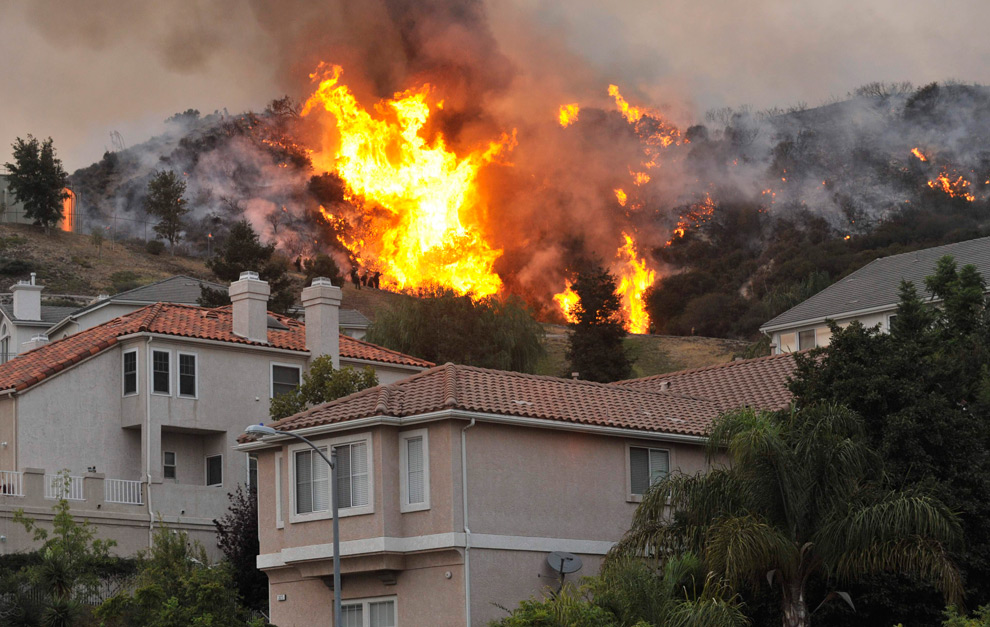This week looked at Station Fire in ArcGIS. We are looking at the 2009 fire of Los Angeles. By early September this fire has burned over 140,000 acres of land, a lot of which were homes and buildings, and had also taken the lives of two firefighters. Firefighters have been working to keep the fire at bay but this was one of the largest fires that Los Angeles has ever seen (inciweb).
Image of Station Fire
This reference map of Los Angeles shows the different counties of Los Angeles. The fire burning would be able to be seen from all different areas of Los Angeles and likewise, these areas would be affected by the smoke and debris from the fires. The fire would be able to travel to these surrounding areas fairly easily because of the proximity. The map shows many different freeways and highways that firefighters could have taken to be able to get closer to these fires in order to put them out so they would not have the chance to spread to closer areas.
This thematic map shows how quickly and intensely the fire was able to grow in size just within a few days. The fire started in one area and August 30th shows a large growth in size as the station fire began spreading to other areas of Los Angeles fairly quickly. Many factors contributed to the fire being able to spread to such great proximity. Weather conditions were very crucial to the fire being able to spread and firefighters did not feel positive about controlling the fire until weather conditions were able to improve but officials say that the fire was so intense that it was creating its own wind patterns (cnn.com.). These extreme factors caused the fire to easily spread into detrimental sizes.
After the fire had subsided, scientists and biologists came in to examine and investigate the damage that the fire did to other aspects such as animal life and soils. Many of the species have been taken into further investigation as well as to be cared for until they can be rereleased into the wild once the environment is safe enough (Archibold). Many different species were also taken in more autopsies to see the affect of the fire on these now dead animals. The aftermath of the fire showed many dead forest trees and there was an effort to try to replant the trees (Sahagun). Reforestation is a costly thing but it is an ecological measure that needs to be taken to somewhat cushion the destruction caused by this fire. The animals and the agriculture has been deeply scarred by this wildfire.
After further investigation, it was found that this fire was possibly started purposely by arson (Batty). Since this fire was started unnaturally by human action, this coupled with the environmental conflicts, this fire was able to spread to large areas in the Los Angeles area. A fire of this size was able to cause a lot of destruction to many homes and lives of people living within proximity of the fire. Firefighters were not able to find anything that may have caused the fire such as a faulty powerline or lightning (Batty). Luckily firefighters were able to extinguish the fire, but not until it was able to claim the lives of many as well as destroying homes and buildings of the surrounding areas of Los Angeles.
"'Angry Fire' Roars across 100,000 California Acres." CNN. CNN, 31 Aug. 2009. Web. 10 June 2012. <http://articles.cnn.com/2009-08-31/us/california.wildfires_1_mike-dietrich-firefighters-safety-incident-commander?_s=PM:US>.
Archibold, Randal C. "After a Devastating Fire, an Intense Study of Its Effects." The New York Times. 3 Oct. 2009. Web. 10 June 2012.
Batty, David. "Los Angeles Wildfire Was Arson, Say Police." The Guardian. Guardian News and Media, 09 Apr. 2009. Web. 10 June 2012. <http://www.guardian.co.uk/world/2009/sep/04/los-angeles-wildfire-arson>.
Sahagun, Louis. "3 Million Trees to Be Planted in Station Fire Burn Area." Los Angeles Times. Los Angeles Times, 15 Apr. 2011. Web. 10 June 2012. <http://articles.latimes.com/2011/apr/15/local/la-me-station-fire-20110415>.
"Station Fire Evening Update Aug. 31, 2009." (2009): n. pag. Web. 10 Jun 2012. <http://inciweb.org/incident/article/9360/>.



No comments:
Post a Comment